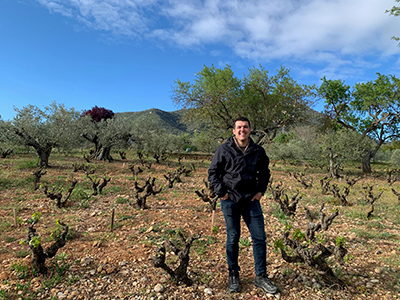
The son of restaurateurs from Pamplona, Josu Amatria studied agronomy in his hometown. He did not see a clear link between the lectures he attended and anything he could be passionate about until he discovered wine. He went on to study winemaking in Logroño and ventured to experience the grape harvest in Chile and California. After working in various wineries in Navarra, such as Artazu, Monasterio de la Oliva, Aroa and Quaderna Vía, where he keeps a small space for his wines, he started his own project in the 2021 vintage, with the support of his parents and his partner, Raquel Elizalde, who divides her time between her job as a lawyer and her work at the winery.
Although he grew up in Pamplona, Josu is based in Ayegui, his home village in the heart of the Tierra Estella sub-region. Ayegui has a long winemaking tradition around the Irache Monastery and Amatria's wish is to put it back on the wine map by creating a wine route along the Camino de Santiago through Tierra Estella and the Sonsierra of Navarra, without excluding the part of Navarra that lies within the DOCa. Rioja.
In terms of grape varieties, the focus is on Garnacha, the dominant grape in the area's old vineyards. In fact, Amatria is becoming a collector of small plots, some of which he already owns and some of which he leases. Some of the latter are in the hands of octogenarian local growers who, unlike their neighbours, have decided not to uproot their vines and continue to look after them. In most cases, however, it is Josu himself who tends the vineyards.
In a relatively short space of time, Amatria has taken over a mosaic of around four hectares of small plots in the villages of Lacar and Ayegui in Tierra Estella, as well as Artazu, Cirauqui and Mañeru, further west in the Valdizarbe sub-area, plus a small vineyard in San Martín de Unx (Baja Montaña), which is outside his working territory but which he could not resist buying when the opportunity arose. Not all of these vineyards are fully productive, as some are still in the process of being recovered. He is also trying to increase the area under vine by planting mass selections from his old vines in neighbouring plots.
Determined to forge a connection between Rioja and Navarra, Amatria has also set his sights on some of the villages of the Sonsierra Navarra, such as Viana, Bargota or Aras.
His range is set to follow a Burgundian structure, with regional wines at the base, followed by village, site and single-vineyard wines. For the time being, three wines have been released. In Navarra he makes the entry-level red Despistado (around €10, 1,300 bottles), a young Garnacha fermented in stainless steel; and Amatria Selección Garnacha (around €22, 1,500 bottles), made from vines over 85 years old and aged for 12 months in 500-litre barrels. This is a fragrant, expressive red with low extraction that shows depth, a refined texture and a fresh, aromatic finish.
In Rioja, he was encouraged by Garnacha expert Juan Carlos Sancha to make El Temblón (€22) from grapes grown at Valdeponzos, a hundred-year-old Garnacha vineyard in the Najerilla Valley. The winemaking style is similar to that of the Selección Garnacha.
Amatria regularly uses different percentages of stems to ferment its Garnachas.
But perhaps the most interesting wines are in the pipeline, particularly a single-vineyard Garnacha from a site literally on the edge of Ayegui, but with enough land uphill to accommodate new plantings.
Most popular
NEWSLETTER
Join our community of Spanish wine lovers


